International Journal of Computer Network and Information Security @ijcnis
Статьи журнала - International Journal of Computer Network and Information Security
Все статьи: 1177

Risk Forecasting of Data Confidentiality Breach Using Linear Regression Algorithm
Статья научная
The paper focuses on the study of cyber security in Ukraine and creation of a predictive model for reducing the risk of identified cyber threats. Forecasting is performed using a linear regression model, taking into account the optimal dependence of specific threats in the field of cyber security of Ukraine on variables characterizing capabilities / vulnerabilities of cyber security. An unique empirical base was used for the analysis, which was formed on the basis of an expert survey of the cyber security system’s subjects in Ukraine. In order to increase the representativeness of the research, based on the selection of reliable expert population, data cleaning is provided. Methodological research is based on a risk-oriented approach, which provided a risk assessment of the spread of cyber threats and, on this basis, the determination of capabilities / vulnerabilities of the cyber security system in Ukraine. The value of the research is formed not only by assessing the risks of the spread of cyber threats, but by a more in-depth analysis of the dependence of the cyber threats’ level on the vulnerability of the cyber security system based on the search for optimal and statistically significant relationships. The experiment was conducted on the basis of determining the optimal model for forecasting the risk of the spread of one of the most significant threats in Ukraine – data confidentiality breach (54.67%), depending on the variables that characterize the capabilities / vulnerabilities of the cyber security system in Ukraine. The experiment showed that the optimal model emphasizes the predictors characterizing the vulnerability of the organizational cyber security system – "Departmental level of cybersecurity monitoring" and capabilities: "The level of use of risk management approaches at the operational level" and "The level of methodological support for cybersecurity of the critical infrastructure system".
Бесплатно
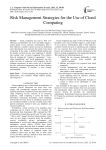
Risk Management Strategies for the Use of Cloud Computing
Статья научная
Cloud computing may lead to both cost-efficiency and flexibility, but it also inevitably triggers a certain degree of loss exposure. Unfortunately, there is little objective, scientific research focused on identifying and evaluating the loss exposure that results from cloud computing. In this study, a modified Delphi method and the analytic network process were employed to identify and evaluate risks of cloud computing. This research finds all solutions for "contract or agreements", "cross-cloud compatibility" and "social engineering" can only reduce the risks of recurrence (risk frequency) but not eliminate recurrences. In other words, risk is inevitable, but risks with severe consequences may be heavy burdens. Purchasing insurance, if possible, is also strongly recommended.
Бесплатно
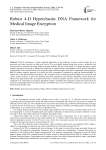
Robust 4-D Hyperchaotic DNA Framework for Medical Image Encryption
Статья научная
With the integration of cloud computing approaches in the healthcare systems, medical images are now processed and stored remotely on third-party servers. For such digital medical image data, privacy, protection, and security must be maintained by using image encryption methods. The aim of this paper is to design and apply a robust medical encryption framework to enhance the protection of medical image transformation and the patient information confidentiality. The proposed Framework encrypt the digital medical images using DNA computation and hyperchaotic RKF-45 random sequence approach. For which, the DNA computation is enhanced by applying hyperchaoticRKF-45 random key to the different Framework phases. The simulation results on different medical images were measured with various security analyses to prove the proposed framework randomness and coherent. Simulation results showed the ability of the hyperchaotic DNA encryption framework to withstand multiple electronic attacks with high performance compared to its counterparts of encryption algorithms. Finally, simulation and comparative studies have shown that, the proposed cryptography framework reported UACI and NPCR values 33.327 and 99.603 respectively, which are near to the theoretical optimal value.
Бесплатно
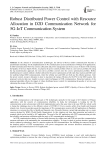
Статья научная
In the domain of communication technologies, the Device-to-Device (D2D) communication becomes a predominant technology for the implementation of 5G communication system and Internet of Things (IoT) applications. In D2D communication Network, resource allocation and power management are the key areas of interest with ensuring the Quality of Services (QoS). Firstly, we propose the power control problem which is a non-convex problem. By using the log transformation approach, the non-convex problem converts into the convex optimization problem. Robust distributed power control method is further utilized for the power optimization at both ends (base station and D2D user) for underlay Inband D2D communication, where the cellular user and D2D user both use the cellular spectrum. After the power control, resource allocation is done to maximize the energy efficiency by 66.67% for the D2D system. Our proposed work provides new insight to power control techniques in D2D communication. Numerical analysis of the proposed algorithm reflects the impact of robust distributed power control for maintaining the quality of services and enhancing the energy efficiency of the system.
Бесплатно
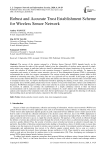
Robust and Accurate Trust Establishment Scheme for Wireless Sensor Network
Статья научная
The success of the mission assigned to a Wireless Sensor Network (WSN) depends heavily on the cooperation between the nodes of this network. Indeed, given the vulnerability of wireless sensor networks to attack, some entities may engage in malicious behavior aimed at undermining the proper functioning of the network. As a result, the selection of reliable nodes for task execution becomes a necessity for the network. To improve the cooperation and security of wireless sensor networks, the use of Trust Management Systems (TMS) is increasingly recommended due to their low resource consumption. The various existing trust management systems differ in their methods of estimating trust value. The existing ones are very rigid and not very accurate. In this paper, we propose a robust and accurate method (RATES) to compute direct and indirect trust between the network nodes. In RATES model, to compute the direct trust, we improve the Bayesian formula by applying the chaining of trust values, a local reward, a local penalty and a flexible global penalty based on the variation of successful interactions, failures and misbehaviors frequency. RATES thus manages to obtain a direct trust value that is accurate and representative of the node behavior in the network. In addition, we introduce the establishment of a simple confidence interval to filter out biased recommendations sent by malicious nodes to disrupt the estimation of a node's indirect trust. Mathematical theoretical analysis and evaluation of the simulation results show the best performance of our approach for detecting on-off attacks, bad-mouthing attacks and persistent attacks compared to the other existing approaches.
Бесплатно
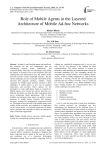
Role of Mobile Agents in the Layered Architecture of Mobile Ad-hoc Networks
Статья научная
In today's world mobile agents and mobile ad-hoc networks are the two technologies that are contributing towards better connectivity and communicability. When the two technologies used jointly, the interest is increased. Due to the properties like self-configuration and infrastructure-less, the mobile ad-hoc networks provide various remarkable features. But the various challenges are also associated with mobile ad-hoc networks like dynamic topology, mobility, energy constraint etc. Mobile agent provides solution to these challenges. A mobile agent is a new way of computer interactions and provides better options for the developers to create applications based on connectivity. Mobile agents move around the ad-hoc networks in a different and better way than the other widespread client server architecture based applications. Due to their mobility and autonomy these agents can perform various functions in mobile ad-hoc networks like topology discovery, routing, key management, congestion control etc. The paper reviews the role of the mobile agents in the mobile ad-hoc networks, and emphasizes its application on the various layers of a layered architecture of mobile ad-hoc networks and concludes its merits as compared to other conventional approaches.
Бесплатно
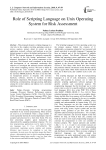
Role of scripting language on Unix operating system for risk assessment
Статья научная
This proposed dynamic scripting language is a vital role in the complex real-time operating system to review, analysis, protect, detect & correct on data, application, network, software and hardware as per the desired manner to achieve the highest performance of the RTOS. The dynamic language is a primarily responsible for analysis of the fine tuning, performance, fault-tolerance, throughput of the system components at the right time. This research work contributes to the design and development of an automated mechanism that objective to investigate the minimal resource utilization to the robust computing services. We have to define & deployment the Unix scripting codes for real time operating system to achieve the reliability, scalability of the real-time MIMD platform. We have to run this SPL on background process to integrate with real-time hardware, software, network to facilitate to other dependants components. This dynamic code is integrating, interfacing, communicating, message passing, replicating among the several subjects and objects over a real-time operating system.
Бесплатно
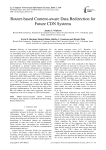
Router-based Content-aware Data Redirection for Future CDN Systems
Статья научная
Delivery of data-enriched applications has become a top priority on the Internet, and Internet users are demanding faster and higher-quality services. Cater such requirements, Content Delivery Networks (CDNs) were introduced. However, the growth rate of information on the Internet requires infrastructural modifications to keep the consistency while maintaining quality of the Internet services. To this end, the Service-oriented Router is introduced to provide content based services by shifting the current Internet infrastructure to information-based open innovation platform. In this study, initially we provide implementation notes of a software-designed SoR. Then we propose a new method of CDN Request Redirection (RR) (SoR-based RR), which is designed to redirect packets based on the content of packets and the status of content servers using an SoR as an edge router of a CDN. Furthermore, we present the design and implementation of a prototype to realize the SoR-based RR in a testing network. By analyzing the result of the prototype implementation, we show that the SoR-based RR can enhance the both client experience and faster adaptations to the server changes in CDN environments.
Бесплатно
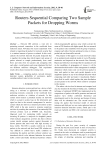
Routers Sequential Comparing Two Sample Packets for Dropping Worms
Статья научная
Network IDS perform a vital role in protecting network connection in the worldwide from malicious attack. Nowadays the recent experiment work related to inspecting the packet for network security that is a minimal amount of process overhead. In this work, analysis the network intrusion for packet inspection that is together the testing data which inspect only group of packet selected as sample predominantly from small flows and select first two packets and comparing with each other overall packets and create tabelazied for find out different malicious debuggers. This experiment results shows that overcome the existing work.
Бесплатно
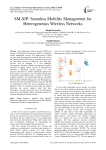
SM-SIP: Seamless Mobility Management for Heterogeneous Wireless Networks
Статья научная
Next-generation wireless networks (NGN) and internet of Thing (IoT) become two leaders of designing mobile multimedia services. The deployment of these services using heterogeneous wireless networks will be the important factor that leads to profound change in the way that these services are delivered. Also, how these services will be managed is a real challenge. Consequently, Seamless mobility management should be provided to support various services in heterogeneous networks. A SIP-based network appears as a very attractive alternative to mobile multimedia applications. In this paper, we introduce a novel mobility management strategy for mobile SIP networks, in which we develop a seamless handover used mobile SIP scheme called SM-SIP (Seamless Mobility Management for Heterogeneous Wireless Networks for Mobile SIP environment). SM-SIP can significantly reduce the system signaling cost and handover delay, by proactively processing the address allocation and session updates using link layer information of wireless networks. Also, our performance study shows that SM-SIP reduces efficiently packets loss using an anticipated buffering scheme.
Бесплатно
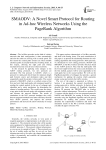
SMAODV: A Novel Smart Protocol for Routing in Ad-hoc Wireless Networks Using the PageRank Algorithm
Статья научная
The Ad-Hoc networks are the kind of wireless networks that their configuration is done automatically and also the nodes are moving with a certain speed. For this reason the created paths (routes) are often unstable and these paths are usually broken by switching nodes. In this respect, choosing the right path and routing mechanism become more diverse in these networks. In this research by applying some changes to the AODV routing protocols, two new protocols are presented: The first protocol is SAODV, which is a protocol for multi-path which finds the minimum length path between source and destination nodes and then sequentially sends the packets in these paths. The second protocol is SMAODV, which is a verified version of the first one but it finds multi-paths with minimum length for sending the control packets by the use of webpage rank algorithm and a smart mechanism for determining the amount of sending packets. This would cause the energy at any point in the network nodes with minimum variance and increase the network lifetime. The results of simulations in the NS-2 network simulator also verify that our proposed methods have better efficiency than the basic AODV protocol, and improve the network performance and decrease the end-to-end delay of receipt packets.
Бесплатно
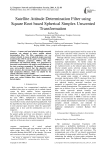
Статья научная
A square root based spherical simplex unscented transform was adopted in micro satellite attitude determination filter. The filter computation cost was reduced evidently by means of spherical simplex unscented transformation (SSUT) and the square root technique with modified Rodrigues parameters (MRPs). The filter performance and numerical stability were guaranteed by unscented transformation with positive-semi definiteness of the state covariance propagation. The simulation results of some micro-satellite showed that this algorithm could insure accuracy, fast convergence and high robustness with high computation efficiency, which was suitable for the attitude estimation of micro-satellite.
Бесплатно
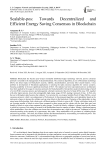
Scalable-pos: Towards Decentralized and Efficient Energy Saving Consensus in Blockchain
Статья научная
Blockchain has become peer-to-peer immutable distributed ledger technology network, and its consensus protocol is essential to the management of decentralized data. The consensus algorithm, at core of blockchain technology (BCT), has direct impact on blockchain's security, stability, decentralization, and many other crucial features. A key problem in development of blockchain applications is selecting the right consensus algorithm for various scenarios. Ensuring scalability is the most significant drawback of BCT. The industry has been rejuvenated and new architectures have been sparked by the usage of consensus protocols for blockchains(BC). Researchers analyzed shortcomings of proof of work (PoW) consensus process and subsequently, alternative protocols like proof of stake (PoS) arose. PoS, together with other improvements, lowers the unimaginably high energy usage of PoW, making it protocol of time. In PoS, only the user with highest stake becomes the validator. To overcome this, we propose Scalable Proof of Stake (SPoS), a novel consensus protocol, which is an enhancement of PoS protocol. In the proposed algorithm, each stakeholder based on the stake gets a chance to become the validator and can mine blocks in the blockchain. Clustering of the stakeholders is done using mean shift algorithm. Each cluster gets a different number of blocks to mine in BC. Cluster with highest stake will get a greater number of blocks to mine when compared to other groups and the cluster with the least stake gets least number of blocks to mine when compared to other groups. To mine the blocks, validator is chosen based on the cluster in which he is present. Fair mining is ensured for all stakeholders based on number of stakes. Mining is distributed among all the stakeholders. Since the validators are chosen fast, the transaction rate is high in the network. Validators in PoS are selected according to the quantity of cryptocurrency they stake. More stakeholders will get chance of validating blocks and receiving rewards. Over time, this reduces fairness and decentralization by concentrating on wealth and power. This is addressed in SPoS using clustering-based validator assignment.
Бесплатно

Scheduling in Grid Systems using Ant Colony Algorithm
Статья научная
Task scheduling is an important factor that directly influences the performance and efficiency of the system. Grid computing utilizes the distributed heterogeneous resources in order to support complicated computing problems. Grid can be classified into two types: computing grid and data grid. Job scheduling in computing grid is a very important problem. To utilize grids efficiently, we need a good job scheduling algorithm to assign jobs to resources in grids. This paper presents a new algorithm based on ant colony optimization (ACO) metaheuristic for solving this problem. In this study, a proposed ACO algorithm for scheduling in Grid systems will be presented. Simulation results indicate our ACO algorithm optimizes total response time and also it increase utilization.
Бесплатно
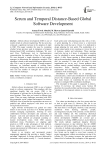
Scrum and Temporal Distance-Based Global Software Development
Статья научная
Global software development (GSD) is one of modern trends in software engineering. The last years has witnessed a significant increase in the adoption of Agile in GSD .This paper considers the issue by examining whether Scrum practices used in mitigation of temporal distance-based GSD coordination challenges. We were used Cisco TelePresence tool in Synchronization communication for simulation of face to face meetings. We were designed a simple algorithm to help project managers in determining the appropriate strategies. This algorithm is based on the temporal difference between the sites. This is may be great or simple. Through temporal difference, we calculated number of working hours overlapping. Which are classified in the three cases and each case has number of strategies are sufficient to overcome this challenges.
Бесплатно
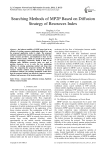
Searching Methods of MP2P Based on Diffusion Strategy of Resources Index
Статья научная
The inherent mobility of MP2P peers lead to an efficient of existing resources positioning method low, and the proposed application model is single. The proposed methods considered the resource positioning in the direction of the resource provider's, and implement it base on the diffusion resource index, which are spread in the model of epidemic. Networking connectivity model is built in the diffusion path. Diffusion resources index are used to position resources, so as to solve the low positioning efficiency of existing positioning method and large time delay. By comparing the proposed method, the flooding resource location method and the Structural resources localization methods, the obtained simulation results show that the proposed method can effectively improve resource efficiency and accuracy of the location method.
Бесплатно
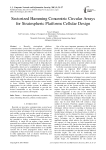
Sectorized Hamming Concentric Circular Arrays for Stratospheric Platforms Cellular Design
Статья научная
Recently, stratospheric platform communications system (SPs) has gained great interest due to its superior performance compared to conventional communications systems. This paper addresses one of the major performance keys in SPs which is the cellular design based on adaptive concentric circular arrays (CCA). The proposed design technique aims to provide circular cells at any elevation angle to overcome the cell flattening and broadening which result in ellipsoidal cell shape. The cell footprint is controlled by adjusting the beamwidths which can be established by sectorizing the CCA and tapering the current amplitudes of the effective sectors by Hamming function while the others are muted and the resulted array is called Sectorized Hamming tapered CCA (SHTCCA). In this array, each sector has an angular width of 90o and some and two opposite sectors are fully fed while the others has less number of quarter-circular arrays. The tapering of the active sectors results in lower sidelobe levels which is a paramount improvement for the cellular systems. In addition, the SHTCCA is analyzed and optimized to provide the desired beamwidths at any elevation angle that are needed to design circular cell footprint.
Бесплатно
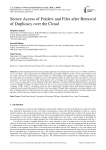
Secure Access of Folders and Files after Removal of Duplicacy over the Cloud
Статья научная
Cloud computing is an emerging concept that makes better use of a large number of distributed resources. The most significant issue that affects the cloud computing environment is resource provisioning. Better performance in the shortest amount of time is an important goal in resource provisioning. Create the best solution for dynamically provisioning resources in the shortest time possible. This paper aims to perform resource provisioning with an optimal performance solution in the shortest time. Hybridization of two Meta-heuristics techniques, such as HSMOSA (Hybrid Spider Monkey Optimization with Simulated Annealing), is proposed in resource provisioning for cloud environment. Finds the global and local value using Spider Monkey Optimization's (SMO) social behavior and then utilizes Simulated Annealing (SA) to search around the global value in each iteration. As a result, the proposed approach aids in enhancing their chances of improving their position. The CloudSimPlus Simulator is used to test the proposed approach. The fitness value, execution time, throughput, mean, and standard deviation of the proposed method were calculated over various tasks and execution iterations. These performance metrics are compared with the PSO-SA algorithm. Simulation results validate the better working of the proposed HSMOSA algorithm with minimum time compared to the PSO-SA algorithm.
Бесплатно
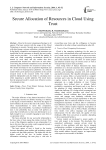
Secure Allocation of Resources in Cloud Using Trust
Статья научная
Cloud is the recent emerging technology in all aspects. The basic concern with the usage of this Cloud Technology is security. Security poses a major drawback with data storage, resource utilization, virtualization, etc. In the highly competitive environment the assurances are insufficient for the customers to identify the trust worthy cloud service providers. As a result all the entities in cloud and cloud computing environment should be trusted by each other and the entities that have communication should have valid trust on each other. Trust being the profound component in any network has attracted many researchers for research in various ways. The models developed so far are platform dependent and are not valid for heterogeneous platforms. An efficient model which can be ported on any platform is the current research trend in the research world. Our model is platform independent and also helps in calculating trust while migrating to another platform. The result shows that the proposed model is much more efficient in terms of computation time.
Бесплатно
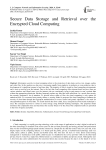
Secure Data Storage and Retrieval over the Encrypted Cloud Computing
Статья научная
Information security in cloud computing refers to the protection of data items such as text, images, audios and video files. In the modern era, data size is increasing rapidly from gigabytes to terabytes or even petabytes, due to development of a significant amount of real-time data. The majority of data is stored in cloud computing environments and is sent or received over the internet. Due to the fact that cloud computing offers internet-based services, there are various attackers and illegal users over the internet who are consistently trying to gain access to user’s private data without the appropriate permission. Hackers frequently replace any fake data with actual data. As a result, data security has recently generated a lot of attention. To provide access rights of files, the cloud computing is only option for authorized user. To overcome from security threats, a security model is proposed for cloud computing to enhance the security of cloud data through the fingerprint authentication for access control and genetic algorithm is also used for encryption/decryption of cloud data. To search desired data from cloud, fuzzy encrypted keyword search technique is used. The encrypted keyword is stored in cloud storage using SHA256 hashing techniques. The proposed model minimizes the computation time and maximizes the security threats over the cloud. The computed results are presented in the form of figures and tables.
Бесплатно

